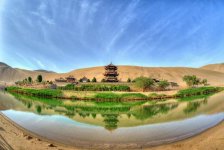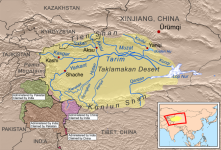acespicoli
Well-known member
ok so heres my interest indica from china moab desert oasis strains im thinking this tour
tell me your ideas ?

this one is silk road tours kashgar and hotan seem like a good place to start
Cannabis in China
From Wikipedia, the free encyclopedia

Cannabis by the roadside, Jiuquan, Gansu
Cannabis in China is illegal. However, hemp grows in China, and historically has been used for fiber, as well as for some ritual purposes within Taoism.
Chinese etymology
Má (Mandarin pronunciation: [mǎ]), a Chinese word for cannabis, is represented by the Han character 麻.[SUP][1][/SUP][SUP][2][/SUP][SUP][3][/SUP] The term ma, used to describe medical marijuana by 2700 BCE, is the oldest recorded name for the hemp plant.[SUP][4][/SUP]
The word ma has been used to describe the cannabis plant since before the invention of writing five-thousand years ago. Ma might share a common root with the Proto-Semitic word mrr, meaning "bitter." Evidence of the earliest human cultivation of cannabis was found in Taiwan.[SUP][5][/SUP][SUP][6][/SUP][SUP][7][/SUP]Ancient Chinese prose and poems, including poetry in the Shi jing (Book of Odes), mention the word ma many times. An early song refers to young women weaving ma into clothing.[SUP][1][/SUP][SUP][8][/SUP][SUP][7][/SUP]
The word ma is often paired with the Chinese word for "big" or "great" to form the compound word dama or 大麻 (dàmá). Dama is sometimes used to describe industrial hemp, as there is a negative connotation meaning "numbness" associated with the word ma by itself.[SUP][9][/SUP][SUP][10][/SUP] Historical Chinese medical texts (c. 200 CE) through contemporary twentieth century Chinese medical literature discuss individual terms for ma, including mafen (麻蕡), mahua (麻花), and mabo (麻勃), referring to specific parts of the male and female flowers of a cannabis plant with differing cannabinoid ratios.[SUP][11][/SUP]
History
In the 19th century, Xinjiang province was a major producer and exporter of hashish, with Yarkand being a major center.[SUP][12][/SUP] Tens of thousands of kilograms annually were exported to British India, legally and under tariff, until 1934 when Chinese authorities cut off the legal trade, though smuggling continued for some years after.[SUP][13][/SUP]
According to the Ministry of Public Security in 2015, cannabis use was on the rise among Chinese youth.[SUP][citation needed][/SUP]
Legal status
In 1985, the People's Republic of China joined the Convention on Psychotropic Substances and identified marijuana as a dangerous narcotic drug, and illegal to possess or use it. The penalty for marijuana possession in China is disputed from various sources, but according to the Law on Public Security Administration Punishments, marijuana smokers shall be detained for 10 to 15 days and fined a maximum of 2,000 yuan.[SUP][14][/SUP]
Cultivation
Cannabis plants are widely grown in Yunnan Province, especially around the city of Dali.[SUP][15][/SUP] However, the Yunnan government began an eradication campaign in 1998 to make the province "cannabis free" by 2000, resulting in less wild and commercially grown cannabis. A similar campaign has also caused a rise in marijuana prices in Xinjiang province.[SUP][16][/SUP]
Taoism
Main article: Cannabis and Taoism
Beginning around the 4th century, Taoist texts mentioned using cannabis in censers. Needham cited the (ca. 570 AD) Taoist encyclopedia Wushang Biyao 無上秘要 ("Supreme Secret Essentials") that cannabis was added into ritual incense-burners, and suggested the ancient Taoists experimented systematically with "hallucinogenic smokes".[SUP][17][/SUP] The Yuanshi shangzhen zhongxian ji 元始上真眾仙記 ("Records of the Assemblies of the Perfected Immortals"), which is attributed to Ge Hong (283-343), says:
For those who begin practicing the Tao it is not necessary to go into the mountains. … Some with purifying incense and sprinkling and sweeping are also able to call down the Perfected Immortals. The followers of the Lady Wei and of Hsu are of this kind.[SUP][18][/SUP]
Lady Wei Huacun 魏華存 (252-334) and Xu Mi 許謐 (303-376) founded the Taoist Shangqing School. The Shangqing scriptures were supposedly dictated to Yang Xi (330-c. 386) in nightly revelations from immortals, and Needham proposed Yang was "aided almost certainly by cannabis". The Mingyi bielu 名醫別錄 ("Supplementary Records of Famous Physicians"), written by the Taoist pharmacologist Tao Hongjing (456-536), who also wrote the first commentaries to the Shangqing canon, says, "Hemp-seeds (麻勃) are very little used in medicine, but the magician-technicians (shujia 術家) say that if one consumes them with ginseng it will give one preternatural knowledge of events in the future."[SUP][19][/SUP][SUP][20][/SUP] A 6th-century AD Taoist medical work, the Wuzangjing 五臟經 ("Five Viscera Classic") says, "If you wish to command demonic apparitions to present themselves you should constantly eat the inflorescences of the hemp plant."[SUP][21][/SUP]
Joseph Needham connected myths about Magu, "the Hemp Damsel", with early Daoist religious usages of cannabis, pointing out that Magu was goddess of Shandong's sacred Mount Tai, where cannabis "was supposed to be gathered on the seventh day of the seventh month, a day of séance banquets in the Taoist communities."[SUP][22][/SUP]
tell me your ideas ?
this one is silk road tours kashgar and hotan seem like a good place to start
Cannabis in China
From Wikipedia, the free encyclopedia

Cannabis by the roadside, Jiuquan, Gansu
Cannabis in China is illegal. However, hemp grows in China, and historically has been used for fiber, as well as for some ritual purposes within Taoism.
Chinese etymology
Má (Mandarin pronunciation: [mǎ]), a Chinese word for cannabis, is represented by the Han character 麻.[SUP][1][/SUP][SUP][2][/SUP][SUP][3][/SUP] The term ma, used to describe medical marijuana by 2700 BCE, is the oldest recorded name for the hemp plant.[SUP][4][/SUP]
The word ma has been used to describe the cannabis plant since before the invention of writing five-thousand years ago. Ma might share a common root with the Proto-Semitic word mrr, meaning "bitter." Evidence of the earliest human cultivation of cannabis was found in Taiwan.[SUP][5][/SUP][SUP][6][/SUP][SUP][7][/SUP]Ancient Chinese prose and poems, including poetry in the Shi jing (Book of Odes), mention the word ma many times. An early song refers to young women weaving ma into clothing.[SUP][1][/SUP][SUP][8][/SUP][SUP][7][/SUP]
The word ma is often paired with the Chinese word for "big" or "great" to form the compound word dama or 大麻 (dàmá). Dama is sometimes used to describe industrial hemp, as there is a negative connotation meaning "numbness" associated with the word ma by itself.[SUP][9][/SUP][SUP][10][/SUP] Historical Chinese medical texts (c. 200 CE) through contemporary twentieth century Chinese medical literature discuss individual terms for ma, including mafen (麻蕡), mahua (麻花), and mabo (麻勃), referring to specific parts of the male and female flowers of a cannabis plant with differing cannabinoid ratios.[SUP][11][/SUP]
History
In the 19th century, Xinjiang province was a major producer and exporter of hashish, with Yarkand being a major center.[SUP][12][/SUP] Tens of thousands of kilograms annually were exported to British India, legally and under tariff, until 1934 when Chinese authorities cut off the legal trade, though smuggling continued for some years after.[SUP][13][/SUP]
According to the Ministry of Public Security in 2015, cannabis use was on the rise among Chinese youth.[SUP][citation needed][/SUP]
Legal status
In 1985, the People's Republic of China joined the Convention on Psychotropic Substances and identified marijuana as a dangerous narcotic drug, and illegal to possess or use it. The penalty for marijuana possession in China is disputed from various sources, but according to the Law on Public Security Administration Punishments, marijuana smokers shall be detained for 10 to 15 days and fined a maximum of 2,000 yuan.[SUP][14][/SUP]
Cultivation
Cannabis plants are widely grown in Yunnan Province, especially around the city of Dali.[SUP][15][/SUP] However, the Yunnan government began an eradication campaign in 1998 to make the province "cannabis free" by 2000, resulting in less wild and commercially grown cannabis. A similar campaign has also caused a rise in marijuana prices in Xinjiang province.[SUP][16][/SUP]
Taoism
Main article: Cannabis and Taoism
Beginning around the 4th century, Taoist texts mentioned using cannabis in censers. Needham cited the (ca. 570 AD) Taoist encyclopedia Wushang Biyao 無上秘要 ("Supreme Secret Essentials") that cannabis was added into ritual incense-burners, and suggested the ancient Taoists experimented systematically with "hallucinogenic smokes".[SUP][17][/SUP] The Yuanshi shangzhen zhongxian ji 元始上真眾仙記 ("Records of the Assemblies of the Perfected Immortals"), which is attributed to Ge Hong (283-343), says:
For those who begin practicing the Tao it is not necessary to go into the mountains. … Some with purifying incense and sprinkling and sweeping are also able to call down the Perfected Immortals. The followers of the Lady Wei and of Hsu are of this kind.[SUP][18][/SUP]
Lady Wei Huacun 魏華存 (252-334) and Xu Mi 許謐 (303-376) founded the Taoist Shangqing School. The Shangqing scriptures were supposedly dictated to Yang Xi (330-c. 386) in nightly revelations from immortals, and Needham proposed Yang was "aided almost certainly by cannabis". The Mingyi bielu 名醫別錄 ("Supplementary Records of Famous Physicians"), written by the Taoist pharmacologist Tao Hongjing (456-536), who also wrote the first commentaries to the Shangqing canon, says, "Hemp-seeds (麻勃) are very little used in medicine, but the magician-technicians (shujia 術家) say that if one consumes them with ginseng it will give one preternatural knowledge of events in the future."[SUP][19][/SUP][SUP][20][/SUP] A 6th-century AD Taoist medical work, the Wuzangjing 五臟經 ("Five Viscera Classic") says, "If you wish to command demonic apparitions to present themselves you should constantly eat the inflorescences of the hemp plant."[SUP][21][/SUP]
Joseph Needham connected myths about Magu, "the Hemp Damsel", with early Daoist religious usages of cannabis, pointing out that Magu was goddess of Shandong's sacred Mount Tai, where cannabis "was supposed to be gathered on the seventh day of the seventh month, a day of séance banquets in the Taoist communities."[SUP][22][/SUP]





